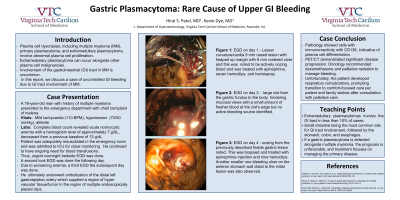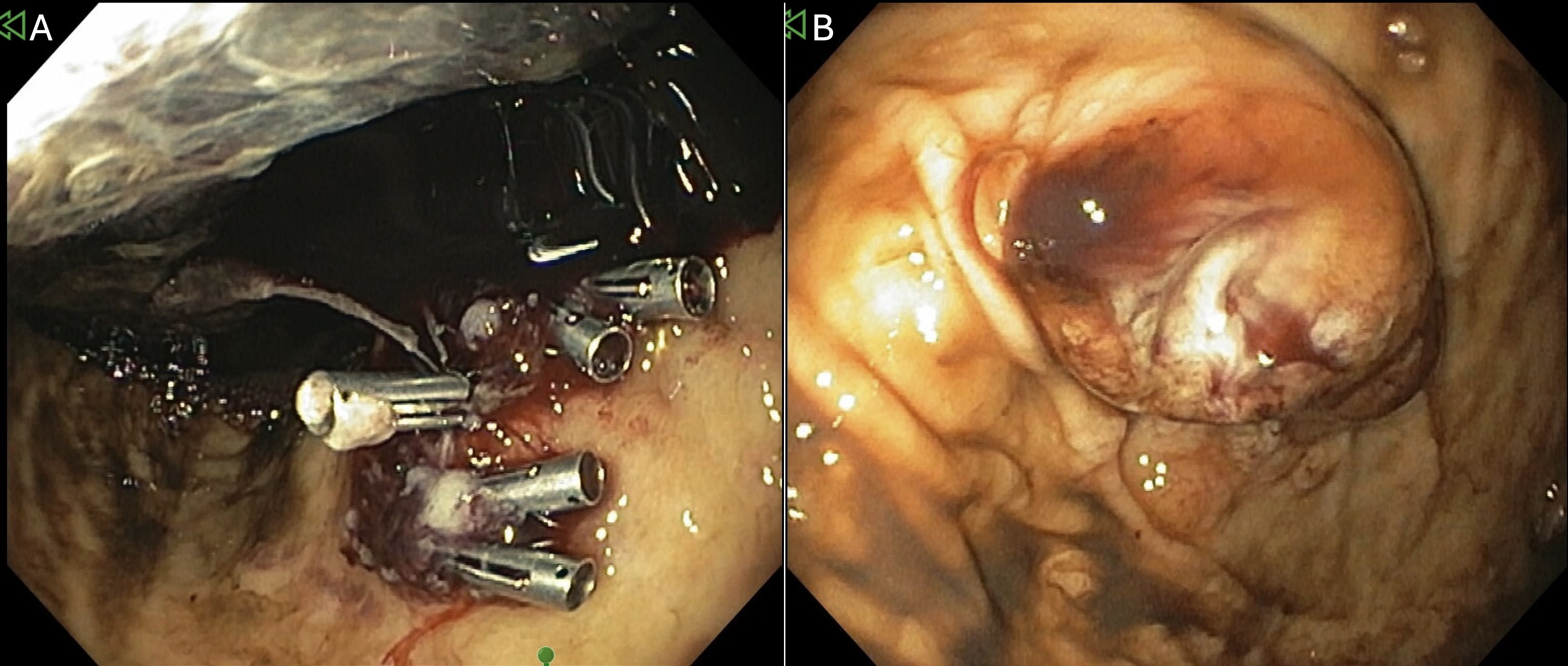Sunday Poster Session
Category: GI Bleeding
P0803 - Gastric Plasmacytoma: Rare Case of Upper GI Bleeding
Sunday, October 27, 2024
3:30 PM - 7:00 PM ET
Location: Exhibit Hall E

Has Audio
- HP
Hiral Patel, MD
Virginia Tech Carilion School of Medicine
Roanoke, VA
Presenting Author(s)
Hiral Patel, MD, Jay Bapaye, MD, Kevin Dye, MD
Virginia Tech Carilion School of Medicine, Roanoke, VA
Introduction: Plasma cell dyscrasias, including multiple myeloma (MM), primary plasmacytoma, and extramedullary plasmacytoma, involve abnormal plasma cell proliferation. Extramedullary plasmacytoma can occur alongside other plasma cell malignancies. Involvement of the gastrointestinal (GI) tract in MM is uncommon. In this report, we discuss a case of uncontrolled GI bleeding due to GI tract involvement of MM.
Case Description/Methods: A 76-year-old man with history of multiple myeloma presented to the emergency department with chief complaint of melena. On presentation, he had mild tachycardia (110 BPM) and low blood pressure (72/50 mmHg). A complete blood count revealed acute normocytic anemia with a hemoglobin level of approximately 7 g/dL, decreased from a previous baseline of 13 g/dL. Urgent overnight bedside Esophagogastroduodenoscopy (EGD) was done due to ongoing need for blood transfusions. EGD revealed actively oozing 8 mm raised lesion with heaped-up margin with 6 mm cratered ulcer. This was treated with epinephrine, seven hemoclips, and hemospray (Figure 1A). A second EGD showed a large clot from the gastric fundus to the body, hindering mucosal views with a small amount of fresher blood at the clot's edge but no active bleeding source identified. Due to worsening anemia, a third EGD the subsequent day noted oozing from the previously described friable gastric lesion. This was biopsied and treated with epinephrine injection and nine hemoclips. Another smaller non-bleeding ulcer on the anterior stomach wall distal to the initial lesion was also observed (Figure 1B). He underwent embolization of the distal left gastroepiploic artery which supplied a region of hyper vascular tissue/tumor in the region of multiple endoscopically placed clips. Pathology showed cells with immunoreactivity with CD138, indicative of plasma cell differentiation. PET/CT demonstrated significant disease progression. Oncology recommended dexamethasone and palliative radiation to manage bleeding. Unfortunately, the patient developed respiratory complications, prompting transition to comfort-focused care per patient and family wishes after consultation with palliative care.
Discussion: Extramedullary plasmacytomas involve the GI tract in less than 10% of cases, with the small intestine being the most common site, followed by the stomach, colon, and esophagus. If a gastric plasmacytoma is detected alongside multiple myeloma, the prognosis is unfavorable, and treatment focuses on managing the primary disease.

Disclosures:
Hiral Patel, MD, Jay Bapaye, MD, Kevin Dye, MD. P0803 - Gastric Plasmacytoma: Rare Case of Upper GI Bleeding, ACG 2024 Annual Scientific Meeting Abstracts. Philadelphia, PA: American College of Gastroenterology.
Virginia Tech Carilion School of Medicine, Roanoke, VA
Introduction: Plasma cell dyscrasias, including multiple myeloma (MM), primary plasmacytoma, and extramedullary plasmacytoma, involve abnormal plasma cell proliferation. Extramedullary plasmacytoma can occur alongside other plasma cell malignancies. Involvement of the gastrointestinal (GI) tract in MM is uncommon. In this report, we discuss a case of uncontrolled GI bleeding due to GI tract involvement of MM.
Case Description/Methods: A 76-year-old man with history of multiple myeloma presented to the emergency department with chief complaint of melena. On presentation, he had mild tachycardia (110 BPM) and low blood pressure (72/50 mmHg). A complete blood count revealed acute normocytic anemia with a hemoglobin level of approximately 7 g/dL, decreased from a previous baseline of 13 g/dL. Urgent overnight bedside Esophagogastroduodenoscopy (EGD) was done due to ongoing need for blood transfusions. EGD revealed actively oozing 8 mm raised lesion with heaped-up margin with 6 mm cratered ulcer. This was treated with epinephrine, seven hemoclips, and hemospray (Figure 1A). A second EGD showed a large clot from the gastric fundus to the body, hindering mucosal views with a small amount of fresher blood at the clot's edge but no active bleeding source identified. Due to worsening anemia, a third EGD the subsequent day noted oozing from the previously described friable gastric lesion. This was biopsied and treated with epinephrine injection and nine hemoclips. Another smaller non-bleeding ulcer on the anterior stomach wall distal to the initial lesion was also observed (Figure 1B). He underwent embolization of the distal left gastroepiploic artery which supplied a region of hyper vascular tissue/tumor in the region of multiple endoscopically placed clips. Pathology showed cells with immunoreactivity with CD138, indicative of plasma cell differentiation. PET/CT demonstrated significant disease progression. Oncology recommended dexamethasone and palliative radiation to manage bleeding. Unfortunately, the patient developed respiratory complications, prompting transition to comfort-focused care per patient and family wishes after consultation with palliative care.
Discussion: Extramedullary plasmacytomas involve the GI tract in less than 10% of cases, with the small intestine being the most common site, followed by the stomach, colon, and esophagus. If a gastric plasmacytoma is detected alongside multiple myeloma, the prognosis is unfavorable, and treatment focuses on managing the primary disease.

Figure: Figure 1: A) Actively oozing 8 mm raised lesion with heaped-up margin with 6 mm cratered ulcer status post placement of hemoclips B) Another smaller non-bleeding lesion with heaped up margin/cratered ulcer
Disclosures:
Hiral Patel indicated no relevant financial relationships.
Jay Bapaye indicated no relevant financial relationships.
Kevin Dye indicated no relevant financial relationships.
Hiral Patel, MD, Jay Bapaye, MD, Kevin Dye, MD. P0803 - Gastric Plasmacytoma: Rare Case of Upper GI Bleeding, ACG 2024 Annual Scientific Meeting Abstracts. Philadelphia, PA: American College of Gastroenterology.
